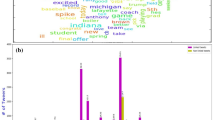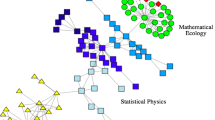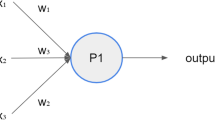Abstract
Social network analysis can provide insight into the educational research community as it manifests and evolves online. This study presents a social network analysis of Twitter use during the American Educational Research Association 2017 Annual Conference. The overall social network is sparse with low density, with a few very active nodes and many unconnected Twitter users. Tweets were positive or neutral and rarely negative. Degree of centrality and of closeness of the top 10 users is high, relative to the top 100 users as centrality, closeness, and betweenness taper off quickly. We interpret this as due to the large number of non-intersecting special interest groups that dilute the overall density of the network. Future social network analysis studies should compare SIGs on various metrics and track their developments over time.



Similar content being viewed by others
Explore related subjects
Discover the latest articles and news from researchers in related subjects, suggested using machine learning.References
Abbasi, A., & Altmann, J. (2011). On the correlation between research performance and social network analysis measures applied to research collaboration networks. 2011 44th Hawaii International Conference on System Sciences, 1–10. https://doi.org/10.1109/HICSS.2011.325.
Agarwal, A., Xie, B., Vovsha, I., Rambow, O., & Passonneau, R. (2011). Sentiment analysis of twitter data. In Proceedings of the workshop on languages in social media (pp. 30–38). Association for Computational Linguistics.
Borgatti, S. P., Mehra, A., Brass, D. J., & Labianca, G. (2009). Network analysis in the social sciences. Science, 323(5916), 892–895. https://doi.org/10.1126/science.1165821.
Borgmann, H., Woelm, J. H., Merseburger, A., Nestler, T., Salem, J., Brandt, M. P., … Loeb, S. (2016). Qualitative twitter analysis of participants, tweet strategies, and tweet content at a major urologic conference. Journal of the Canadian Urological Association, 10(1–2February), 39–43. https://doi.org/10.5489/cuaj.3322.
Brandes, U. (2001). A faster algorithm for Betweenness centrality. Journal of Mathematical Sociology, 25(2), 163–177 http://www.inf.uni-konstanz.de/algo/publications/b-fabc-01.pdf.
Brandes, U. (2008). On variants of shortest-path Betweenness centrality and their generic computation. Social Networks, 30(2), 136–145 http://www.inf.uni-konstanz.de/algo/publications/b-vspbc-08.pdf.
Bruun, J., & Brewe, E. (2013). Talking and learning physics: predicting future grades from network measures and force concept inventory pretest scores. Physical Review Special Topics - Physics Education Research, 9, 020109.
Burt, R. S. (2004). Structural holes and good ideas. American Journal of Sociology, 110(2), 349–399. https://doi.org/10.1086/421787.
Chung, A., & Woo, H. (2015). Twitter in urology and other surgical specialties at global conferences. ANZ Journal Of Surgery, 86(4), 224–227. https://doi.org/10.1111/ans.13393.
de Laat, M., Lally, V., Lipponen, L., Simon, R., & J. (2007). Investigating patterns of interaction in networked learning and computer-supported collaborative learning: a role for social network analysis. Journal of Computer Supported Collaborative Learning, 2(1), 87–103.
Desai, T., Shariff, A., Shariff, A., Kats, M., Fang, X., Christiano, C., & Ferris, M. (2012). Tweeting the meeting: an in-depth analysis of twitter activity at kidney week 2011. PLoS One, 7(7), 1–9. https://doi.org/10.1371/journal.pone.0040253.
Erlin, Yusof, N., & Rahman, A. A. (2009). Students’ interactions in online asynchronous discussion forum: A social network analysis. 2009 International Conference on Education Technology and Computer, ICETC 2009, 25–29. https://doi.org/10.1109/ICETC.2009.48.
Freeman, L. C. (1979). Centrality in networks: I. Conceptual clarification. Social Networks, 1, 215–239 http://leonidzhukov.ru/hse/2013/socialnetworks/papers/freeman79-centrality.pdf.
Gao, F., Luo, T., & Zhang, K. (2012). Tweeting for learning: a critical analysis of research on microblogging in education published in 2008-2011. British Journal of Educational Technology, 43, 783–801.
Grunspan, D. Z., Wiggins, B. L., & Goodreau, S. M. (2014). Understanding classrooms through social network analysis: a primer for social network analysis in education research. Cell Biology Education, 13(2), 167–178. https://doi.org/10.1187/cbe.13-08-0162.
Hattem, D., & Lomicka, L. (2016). What the tweets say: a critical analysis of twitter research in language learning from 2009 to 2016. E-Learning and Digital Media, 13(1–2), 5–23. https://doi.org/10.1177/2042753016672350.
Kimmons, R., & Veletsianos, G. (2016). Education scholars’ evolving uses of twitter as a conference backchannel and social commentary platform. British Journal of Educational Technology, 47(3), 445–464. https://doi.org/10.1111/bjet.12428.
Kouloumpis, E., Wilson, T., & Moore, J. (2011). Twitter sentiment analysis: The good the bad and the OMG !. In Proceedings of the Fifth International AAAI Conference on Weblogs and Social Media (pp. 538–541). Association for the Advancement of Artificial Intelligence.
Lee, M., Yoon, H., Smith, M., Park, H., & Park, H. (2017). Mapping a twitter scholarly communication network: a case of the association of internet researchers’ conference. Scientometrics, 112(2), 767–797 https://doi.org/10.1007/s11192-017-2413-z.
Letierce, J., Passant, A., Breslin, J. G., & Decker, S. (2010). Using twitter during an academic conference: The #iswc2009 use-case. Proceedings of the Fourth International {AAAI} Conference on Weblogs and Social Media, 279–282. Retrieved from http://www.aaai.org/ocs/index.php/ICWSM/ICWSM10/paper/view/1523
NetworkX. (2016). Documentation, Release 1.11. https://networkx.readthedocs.io/en/stable/.
Padgett, J., & Ansell, C. (1993). Robust action and the rise of the medici, 1400-1434. American Journal of Sociology, 98(6), 1259–1319. https://doi.org/10.1086/230190.
Pak, A., & Paroubek, P. (2010). Twitter as a corpus for sentiment analysis and opinion mining. In Proceedings of the 7th Conference on International Language Resources and Evaluation (pp. 1320–1326). European Language Resource Association.
Parra, D., Trattner, C., Gómez, D., Hurtado, M., Wen, X., & Lin, Y. (2016). Twitter in academic events: a study of temporal usage, communication, sentimental and topical patterns in 16 computer science conferences. Computer Communications, 73, 301–314. https://doi.org/10.1016/j.comcom.2015.07.001.
Ramanadhan, S., Wiecha, J. L., Emmons, K. M., Gortmaker, S. L., & Viswanath, K. (2009). Extra-team connections for knowledge transfer between staff teams. Health Education Research, 24(6), 967–976. https://doi.org/10.1093/her/cyp030.
Salzmann-Erikson, M. (2017). Mental health nurses’ use of twitter for professional purposes during conference participation using #acmhn2016. International Journal Of Mental Health Nursing., 27, 804–813. https://doi.org/10.1111/inm.12367.
Socher, R., Bauer, J., Manning, C. D., & Ng, A. Y. (2013). Parsing with compositional vector grammars. ACL 2013 - 51st Annual Meeting of the Association for Computational Linguistics, Proceedings of the Conference, 1, 455–465. https://doi.org/10.1017/CBO9781139058452.
Stepanyan, K., Borau, K., & Ullrich, C. (2010). A social network analysis perspective on student interaction within the twitter microblogging environment. Proceedings - 10th IEEE International Conference on Advanced Learning Technologies, ICALT 2010, (July 2010), 70–72. https://doi.org/10.1109/ICALT.2010.27.
Tang, Y., & Hew, K. (2017). Using twitter for education: beneficial or simply a waste of time? Computers & Education, 106, 97–118. https://doi.org/10.1016/j.compedu.2016.12.004.
Twitter. (2017). Twitter announces third quarter 2017 results (pp. 1–7). San Francisco: Twitter Retrieved from http://files.shareholder.com/downloads/AMDA-2F526X/5565213491x0x961127/658476E7-9D8B-4B17-BE5D-B77034D21FCE/TWTR_Q3_17_Earnings_Press_Release.pdf.
Wenger, E. (1998). Communities of practice: learning, meaning, and identity. Learning in doing. Cambridge: Cambridge University Press.
Williams, A., & Woodacre, M. (2016). The possibilities and perils of academic social networking sites. Online Information Review, 40(2), 282–294. https://doi.org/10.1108/oir-10-2015-0327.
Author information
Authors and Affiliations
Corresponding author
Additional information
Publisher’s Note
Springer Nature remains neutral with regard to jurisdictional claims in published maps and institutional affiliations.
Rights and permissions
About this article
Cite this article
Lemay, D.J., Basnet, R.B., Doleck, T. et al. Social network analysis of twitter use during the AERA 2017 annual conference. Educ Inf Technol 24, 459–470 (2019). https://doi.org/10.1007/s10639-018-9787-2
Received:
Accepted:
Published:
Issue Date:
DOI: https://doi.org/10.1007/s10639-018-9787-2




